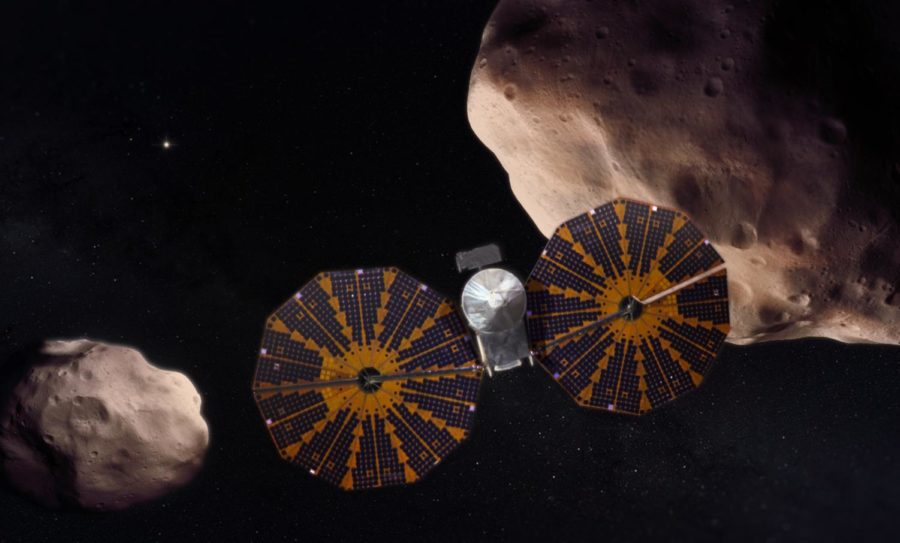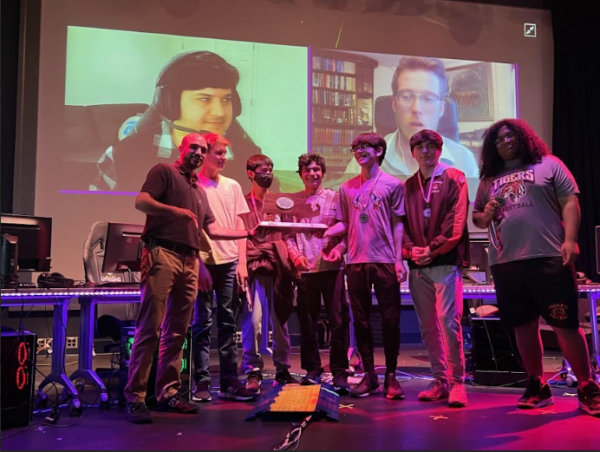Looking Around With Lucy
December 2, 2021
We, as an entire society, are quite familiar with the puzzling concept of space, and our scientists and engineers have spent decades attempting to come up with answers. However, there is one specific question that stands out to us, one that pushes our inquiries to the max: How did we come to be? Humanity has seen great endeavors by major space programs around the world, the arguably most notable one being NASA. Very recently, another mission packed with precise calculations and hope left Cape Canaveral once again; the only difference, compared to past expeditions out into the cosmos, is that it isn’t going to examine another planet for the umpteenth time. NASA has greatly expanded its expectations and optimism for their newest launch, which they have titled Lucy. With it, NASA is hoping to recover long-awaited answers about our Solar System’s past from asteroids, the “fossils” of space.
What’s with the name ‘Lucy’, and why does it sound familiar? NASA’s most recent mission shares the same name with the famous human fossil skeleton recovered in Africa not too long ago. Taking inspiration from the ancient ‘Lucy’ fossil, which provided more clues about humanity’s origins, the Lucy mission hopes to find success while looking for fossils of the Solar System far away from Earth. The asteroids in question, which are also referred to as Trojans, can be found orbiting Jupiter, the largest gas giant, let alone the largest planet circling our Sun. Due to the incredibly far distance between Jupiter and the Sun, the Lucy mission will last for approximately 12 years, with the Lucy probe returning to Earth in 2033, traveling over 4 billion miles through outer space, making the mission one of the longest and challenging endeavors in NASA’s history. Mr. Ames, known for his knowledge, is optimistic about the Lucy probe succeeding in completing its journey. “It’ll [the probe] hopefully make it,” He stated. “I mean the Mars Rover has made it as long as it has.” Thanks to NASA’s massive contribution to fund the mission ($981 million), the Lucy probe is designed with detail and sophistication, which will allow the probe to record the shape, structure, surface features, composition and temperature of each of the seven Trojans it’ll visit. In addition to his faith in the mission, Mr. Ames, considering the complexity and variety of the Lucy probe’s instruments, hopes that it will discover if “there’s water up there,” or perhaps “gases like Jupiter’s got.” He describes how figuring out “the mineral background would be huge,” as well as how “it’d really be cool to pick up life, or any signs of life in an organic material.”
The Trojans, which are composed of two swarms, are highly likely to be holding clues about our Solar System’s beginnings, as stated by various engineers and high-ranking individuals at the Southwest Research Institute. However, it is very important to consider the external effects that they could be facing. The Trojans were predicted to have been formed outside the edges of the Solar System, where there then was a mass re-juggle of objects, leading to the asteroids being thrown into Jupiter’s gravitational pull. All of this movement, followed by billions of years in the colder parts of outer space, most likely has an impact on the condition of the clues the Trojans are carrying. Gabby Ramasci recognizes the possibility of the fossils being worn down by time, expressing how she feels “there will be evidence to find,” but isn’t sure if “it will be sufficient or large enough to necessarily prove anything.” Despite these concerns, NASA has big plans for its near future, partly thanks to the predicted success of the Lucy mission; there have already been developments made on projects and missions surrounding the study of asteroids. For example, the Osiris-Rex mission is coming back to Earth after examining an object called “Bennu”, the Psyche mission will be launching in 2022 to examine the asteroid “Psyche”, and the Dart mission, an asteroid-collision experiment, will be launching sometime this month. “I think that this is super valuable,” Gabby says, regarding NASA’s current focus on asteroids. “We could learn really important things that could tie in with other issues…we could learn things about our past that could help us with medical information, health and wellness, or just having a better understanding [of asteroids and the Solar System].” The ambitions and endeavors being conducted by NASA are fueling people with optimism and great hope for the future, as well as the secrets that space has been holding from us.
Clearly, the Lucy mission has a lot of expectations to meet, and its probe will be relied on to collect incredibly important information about the history of our Solar System. It is with great amounts of hope and aspiration that Lucy will be able to complete its objectives to the fullest extent, and prove that the “fossils” of space do indeed reveal to humanity the planetary origins that we’ve striven to piece together for so long. NASA and other space programs will benefit greatly from this mission, and maybe, their leading scientists and researchers will be able to provide a long-awaited answer to the long-standing question: How did we come to be?




